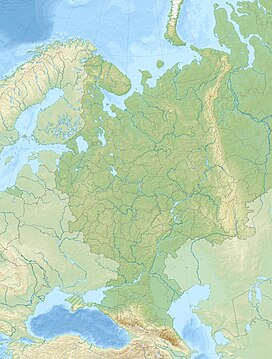Yamantau
Mount Yamantau
Mountain in Bashkortostan, Russia
Mount Yamantau, or Yamantaw (Bashkir: Ямантау, romanized: Yamantaw, Russian: гора Ямантау) is a mountain in the Ural Mountains, located in Beloretsky District, Bashkortostan, Russia. Standing at 1,640 metres (5,380 ft) it is the highest mountain in the Southern Ural section, and is featured within the South Ural Nature Reserve.
This article needs additional citations for verification. (March 2009) |
| Yamantaw | |
|---|---|
 | |
| Highest point | |
| Elevation | 1,640 m (5,380 ft)[1] |
| Prominence | 1,330 m (4,360 ft) |
| Listing | Mountains of Russia |
| Coordinates | 54°15′18″N 58°06′13″E[1] |
| Geography | |
| Country | Russia |
| Republic | Bashkortostan |
| District | Beloretsky |
| Protected area | South Ural Nature Reserve |
| Parent range | Ural Mountains |
| Yamantau | |
|---|---|
| Part of Armed Forces of the Russian Federation | |
| Mezhgorye, Republic of Bashkortostan, Russia | |
| Coordinates | 54.255°N 58.102°E / 54.255; 58.102 |
| Type | Underground military facility |
| Site information | |
| Controlled by | Armed forces of the Russian Federation |
| Condition | Unknown |
| Site history | |
| Built | Under construction (2003) |
| In use | Unknown |
| Garrison information | |
| Garrison | Mezhgorye |
| Occupants | Unknown |
A secret extensive bunker complex has been allegedly built under Mt. Yamantaw, claimed by the United States to be owned by the Russian government or Russian Armed Forces, similar to the Cheyenne Mountain Complex.
The name of the mountain is derived from "Yaman taw" (Яман тау), which translates to "evil mountain", "bad mountain", or "wicked mountain" in the local Bashkir language. The meaning behind the name is believed to originate from the many inconveniences of the mountain: big bear population, surrounding swamps and rocky slopes, resulting in its area being a troublesome herding place. [2]
Yamantaw has two peaks - Big Yamantaw 1,640 metres (5,380 ft) and Small Yamantaw 1,512 metres (4,960 ft). Both peaks are plateaus, with a big area and flat relief.
Up to 1000 - 1100 m elevation, the mountain slope is covered with mixed forest, in some places with driftwood, occasional alpine meadows and rocky outcrops. Above 1100m elevation, there are no trees or bushes, and instead rock streams of various sizes, with grass, flowers and moss start to appear.[2]
Yamantaw, along with Kosvinsky Mountain (600 km to the north), are claimed by the United States of being home to a large secret nuclear facility or bunker, or both.[3] Large excavation projects have been observed by U.S. satellite imagery after the fall of the Soviet Union, as recently as the late 1990s during the government of Boris Yeltsin.[3] During the Soviet era two military garrisons, Beloretsk-15 and Beloretsk-16, and possibly a third, Alkino-2, were built on the site. These garrisons were unified into the closed town of Mezhgorye (Russian: Межгорье) in 1995, and the garrisons are said to house 30,000 workers each, served by large rail lines.[4]
Repeated U.S. questions have yielded several different responses from the Russian government regarding Yamantaw, including it is a mining site, a repository for Russian treasures, a food storage area, and a bunker for leaders in case of nuclear war.[5][4] Responding to questions regarding Yamantaw in 1996, Russia's Defense Ministry stated: "The practice does not exist in the Defense Ministry of Russia of informing foreign mass media about facilities, whatever they are, that are under construction in the interests of strengthening the security of Russia."[4] In 1997, a United States Congressional finding, related to the country's National Defense Authorization Act for 1998, stated that the Russian Federation kept up a "deception and denial policy" about the mountain complex after U.S. officials had given Cheyenne Mountain Complex tours to Russian diplomats, which the finding stated "... does not appear to be consistent with the lowering of strategic threats, openness, and cooperation that is the basis of the post-Cold War strategic partnership between the United States and Russia."[6]
- Yamantau is featured in the video game Metro Exodus where it has been taken over by cannibals.
- Yamantau is featured in the 2010 video game Call of Duty: Black Ops where it houses a base for a fictional chemical weapon – the Nova 6.
- Yamantau is featured the video game Call of Duty Black Ops Cold War as one of the multiplayer maps.
- Yamantau is the name of a map in the video game War Robots, it is based on Yamantau.[7] The map was remastered in version 9.2 [8]
- "Topographic map of Mount Yamantau". opentopomap.org. Retrieved 2023-04-02.
- "Ураловед - гора Ямантау" (in Russian).
- Blair, Bruce G (May 25, 2003). "We Keep Building Nukes For All the Wrong Reasons" (PDF). The Washington Post. Archived from the original (PDF) on 4 March 2016. Retrieved 28 February 2009.
- Gordon, Michael R. (April 16, 1996). "Despite Cold War's End, Russia Keeps Building a Secret Complex". The New York Times. Retrieved 28 February 2009.
- "Yamantau, Beloretsk-15, Beloretsk-16, Alkino-2", Weapons of Mass Destruction, Global Security.
- "Yamantau - War Robots". warrobots.com. Retrieved 2023-07-08.
- "WAR ROBOTS 9.2 UPDATE NOTES - War Robots". warrobots.com. Retrieved 2023-07-08.

